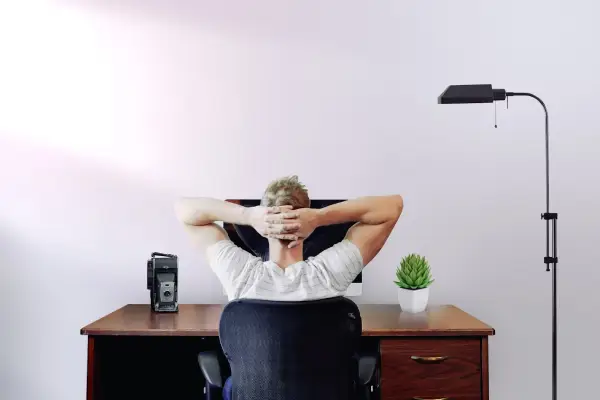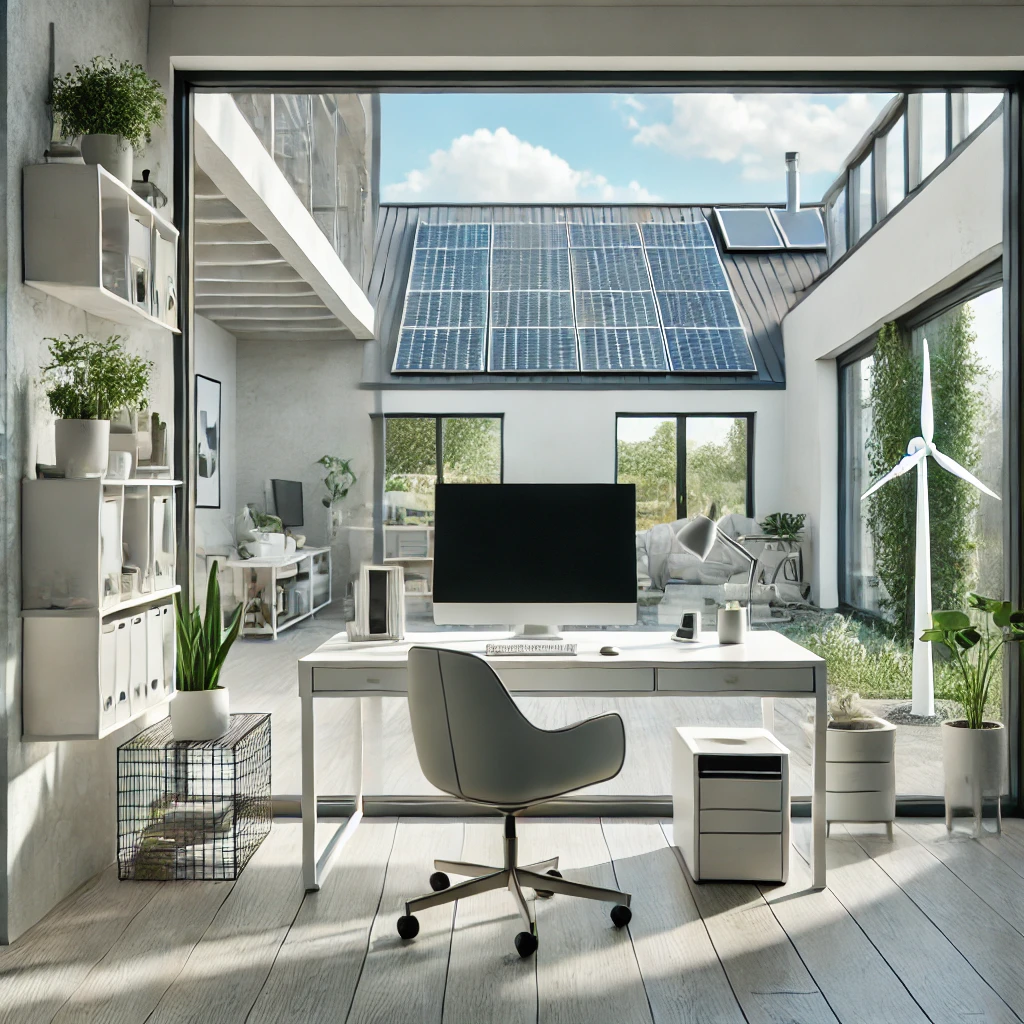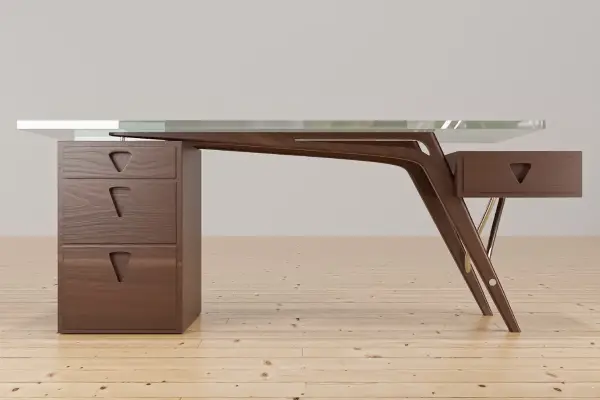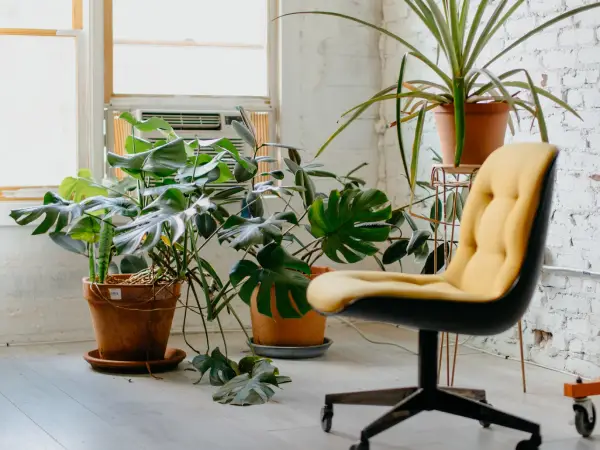Welcome to a journey towards a clutter-free and productive workspace—the heart of your minimalist home office. In today’s fast-paced world, where our homes double as our workspaces, creating an environment that fosters focus and creativity is more crucial than ever. Embracing minimalism isn’t just about aesthetics; it’s a transformative approach to design that enhances efficiency, reduces stress, and promotes a sense of calm.
Your home office should be a sanctuary—a place where distractions are minimized, and productivity thrives. Whether you’re setting up a new workspace or looking to refine your current setup, this guide is your roadmap to creating a clutter-free environment that supports your professional goals and personal well-being.
Join me as we explore practical strategies, from decluttering techniques to choosing functional furniture and organizing digital files, to help you achieve a minimalist home office that inspires productivity and reflects your unique style. Let’s dive in and transform your workspace into a haven of focus and creativity.
Assessing Your Current Space
Before diving into the transformation of your home office into a minimalist haven, it’s essential to take stock of your current setup. Assessing your space not only helps identify areas for improvement but also lays the foundation for creating a clutter-free environment that supports your workflow and enhances productivity.
Evaluating Your Home Office Setup
Begin by stepping back and objectively evaluating your workspace. Take note of how you currently use the space and any challenges you face. Are there items that clutter your desk or distract you from your tasks? Are storage solutions effective, or do they contribute to visual noise?
Identifying Sources of Clutter
Next, pinpoint the sources of clutter in your home office. This could include excessive paperwork, tangled cables, unused furniture, or decor that no longer serves a purpose. Recognizing these elements allows you to prioritize what needs to stay, what can be improved, and what should be removed to create a more streamlined environment.
Understanding Your Workspace Needs and Goals
Consider how you intend to use your home office. Are you primarily working on a computer, conducting meetings, or engaging in creative projects? Understanding your specific needs and goals for the space helps tailor your minimalist approach. It ensures that every item and design choice contributes to functionality and supports your daily tasks effectively.
By assessing your current space with a critical eye, you lay the groundwork for the transformative journey towards a clutter-free and productive minimalist home office. Stay tuned as we delve deeper into practical strategies for decluttering and organizing your workspace effectively.
Decluttering Your Home Office
Now that you’ve assessed your current workspace and identified areas for improvement, it’s time to roll up your sleeves and declutter. Decluttering is the cornerstone of creating a minimalist home office that promotes focus and productivity. By removing unnecessary items and organizing what remains, you’ll create a clean and inspiring environment where work can flourish.
Steps to Declutter Effectively
Sorting and Categorizing Items
Start by sorting everything in your home office into categories: essentials, items to keep but store, items to donate or sell, and items to discard. This process helps you visualize the volume of items you have and makes decision-making easier.
Purging Unnecessary Items
Be ruthless in your decluttering process. Ask yourself if each item serves a purpose or adds value to your work life. If an item hasn’t been used in months or doesn’t contribute to your productivity, it’s likely time to let it go. Consider donating or selling items that are in good condition but no longer serve you.
Organizing Remaining Essentials
Once you’ve streamlined your belongings, focus on organizing the essentials that remain. Invest in storage solutions that maximize space and minimize visual clutter. Use drawers, shelves, and containers to keep items neatly arranged and easily accessible. A well-organized workspace not only looks tidy but also enhances efficiency.
Tips for Maintaining a Clutter-Free Environment
Establishing Daily Habits
Develop simple daily habits to maintain a clutter-free home office. Spend a few minutes at the end of each day tidying up your desk and putting items back in their designated places. Clearing your workspace before you finish each day ensures you start fresh the next morning.
Regularly Reassessing Your Space
Decluttering is an ongoing process, not a one-time task. Schedule regular times to reassess your workspace and make adjustments as needed. This might involve purging additional items that have accumulated or reorganizing your setup to better suit your workflow.
Embracing Minimalism for Enhanced Productivity
By decluttering your home office, you create a focused environment that supports your professional goals and enhances your overall well-being. Stay tuned as we explore further strategies for choosing functional furniture and organizing digital files to maximize your minimalist workspace.
Choosing Functional and Minimalist Furniture
In your journey to create a clutter-free and productive home office, selecting the right furniture plays a pivotal role. Functional and minimalist furniture not only optimizes space but also enhances comfort and efficiency. Here’s how to choose the perfect pieces for your minimalist workspace:
Importance of Ergonomic Design
Investing in ergonomic furniture is crucial for maintaining health and productivity. A comfortable chair that supports your posture and a spacious desk that accommodates your work essentials are essential elements of a minimalist home office. Look for adjustable features that allow you to customize your setup to fit your body and work style.
Selecting Multipurpose Pieces
Opt for furniture that serves multiple functions to maximize space efficiency in your home office. For example, consider a desk with built-in storage compartments or a file cabinet that doubles as a side table. Choosing multipurpose pieces reduces clutter and creates a streamlined environment where everything has a designated place.
Recommendations for Minimalist Furniture
Minimalist Desks
Choose a desk that matches your workspace needs and aesthetic preferences. A clean, simple design with ample workspace is ideal for minimalist decor. Look for desks made from durable materials like wood or metal that blend seamlessly with your office environment.
Functional Chairs
Select a chair that prioritizes comfort and support without sacrificing style. Ergonomic chairs with adjustable height and lumbar support promote good posture and reduce discomfort during long work hours. Choose a design that complements your desk and enhances the overall aesthetic of your workspace.
Organizing with Efficiency in Mind
Storage Solutions
Incorporate storage solutions that blend functionality with minimalist design. Utilize shelves, drawers, and organizers to keep your office essentials neatly arranged and easily accessible. Choose furniture pieces with integrated storage options to maintain a clean and clutter-free workspace.
Enhancing Your Workspace
By carefully selecting functional and minimalist furniture, you create a home office that maximizes space, promotes productivity, and reflects your personal style. Stay tuned as we delve into strategies for organizing digital files and utilizing smart storage solutions to further optimize your minimalist workspace.
Organizing Digital and Physical Files
In today’s digital age, organizing both your physical and digital files is essential for maintaining a clutter-free and efficient home office. A streamlined filing system not only saves time but also reduces stress and enhances productivity. Here’s how to organize your files effectively in a minimalist workspace:
Going Paperless: Tips for Digitizing Documents
Transitioning to a paperless system is a hallmark of a minimalist home office. Digitizing your documents not only reduces physical clutter but also provides easy access to information from anywhere. Here are some tips to help you go paperless:
Use Document Scanners: Invest in a reliable document scanner to digitize paper documents efficiently. Many scanners offer features like automatic feeding and cloud integration, making it easy to organize and access your files digitally.
Cloud Storage Solutions: Utilize cloud storage services such as Google Drive, Dropbox, or OneDrive to store and organize your digital documents securely. Organize files into folders and use descriptive file names to facilitate quick retrieval.
Backup Regularly: Ensure your digital files are backed up regularly to prevent data loss. Cloud storage services often provide automatic backup options, ensuring your documents are safe and accessible at all times.
Creating an Efficient Digital Filing System
Folder Structure: Establish a logical folder structure that mirrors your physical filing system. Organize files by category, project, or date to facilitate easy navigation and retrieval.
Naming Conventions: Adopt a consistent naming convention for your digital files to enhance searchability. Include keywords and dates in file names to quickly identify and retrieve specific documents.
Organizing Physical Files with Minimalism in Mind
Decluttering Paperwork: Sort through physical documents and discard or shred those that are outdated or no longer needed. Keep only essential documents that require physical copies.
File Storage Solutions: Invest in minimalist file organizers or cabinets to store physical documents neatly. Use labels and dividers to categorize and organize files effectively.
Maintaining a Clutter-Free Workspace
Regular Maintenance: Dedicate time each week to review and organize both your digital and physical files. Remove unnecessary documents and ensure everything is stored in its designated place.
Paper Management: Implement a system for handling incoming mail and paperwork to prevent paper clutter from accumulating. Sort mail promptly and file documents as soon as they are processed.
Embracing Digital Minimalism
By organizing your digital and physical files effectively, you create a clutter-free workspace that supports productivity and enhances your overall work experience. Stay tuned as we explore smart storage solutions and tips for maintaining a clean and organized minimalist home office.
Utilizing Smart Storage Solutions
In a minimalist home office, efficient storage solutions are key to maintaining a clean and organized workspace. Smart storage not only maximizes space but also reduces visual clutter, allowing you to focus on your work without distractions. Here’s how to optimize your storage solutions for a clutter-free environment:
Hidden Storage Options to Reduce Visual Clutter
Floating Shelves
Floating shelves provide additional storage without taking up floor space. Install them above your desk or along empty walls to display books, plants, or decorative items while keeping surfaces clear. Choose shelves with clean lines and minimalistic designs to complement your workspace.
Under-Desk Storage
Utilize the space under your desk for storage purposes. Invest in storage bins, baskets, or rolling drawers to keep essentials like office supplies, cables, or paperwork neatly organized and out of sight. This helps maintain a tidy workspace while maximizing usable area.
Utilizing Vertical Space with Shelves and Wall-Mounted Organizers
Wall-Mounted Organizers
Wall-mounted organizers such as pegboards, grid panels, or magnetic boards offer versatile storage solutions for small office supplies, stationery, or tools. Arrange items on these organizers for easy access and to free up valuable desk space.
Vertical Shelving Units
Opt for tall, narrow shelving units that capitalize on vertical space. These units can store books, binders, or decorative items without monopolizing floor space. Choose minimalist designs that blend seamlessly with your office decor.
Innovative Storage Solutions for Small Spaces
Multi-Functional Furniture
Select furniture pieces that incorporate storage capabilities, such as desks with built-in drawers or ottomans with hidden compartments. These multi-functional pieces serve dual purposes while keeping clutter to a minimum.
Modular Storage Systems
Consider modular storage systems that allow you to customize your storage configuration based on your needs. Modular units with stackable shelves or cubes provide flexibility and adaptability to accommodate varying amounts of items.
Creating a Minimalist Aesthetic with Storage Solutions
Simplifying Display Items
Maintain a minimalist aesthetic by carefully curating items displayed on shelves or organizers. Limit decorations to a few meaningful pieces that contribute to the overall ambiance of your workspace without overwhelming the visual space.
Concealing Cables and Wires
Manage cable clutter effectively to maintain a clean and streamlined look. Use cable management solutions such as clips, sleeves, or cable boxes to keep wires organized and out of sight. Wireless devices can further reduce cable-related visual clutter.
Implementing Sustainable Practices
Eco-Friendly Materials
Choose storage solutions made from sustainable materials like bamboo, recycled plastic, or FSC-certified wood. These materials minimize environmental impact while adding a natural touch to your minimalist home office.
Minimalist Mindset
Adopting a minimalist mindset involves thoughtful consumption and intentional organization. Regularly reassess your storage solutions and belongings to ensure they align with your workspace goals and contribute to a clutter-free environment.
By utilizing smart storage solutions effectively, you can create a minimalist home office that promotes productivity, organization, and aesthetic appeal. Stay tuned as we discuss tips for maintaining a clean and clutter-free desk in our next blog section.
Maintaining a Clean and Clutter-Free Desk
A clutter-free desk is not just visually appealing but also essential for maintaining focus and productivity in your minimalist home office. By establishing effective habits and organizing strategies, you can ensure that your workspace remains tidy and conducive to work. Here’s how to maintain a clean and clutter-free desk:
Keeping Only Essentials on Your Desk
Start by decluttering your desk surface and keeping only the essentials within arm’s reach. Identify the items you use frequently throughout the day, such as your computer, notebook, and pens. Store less frequently used items in drawers or designated storage containers to minimize visual distractions.
Cable Management Strategies
Manage cable clutter effectively to maintain a streamlined and organized desk. Use cable clips, ties, or cable sleeves to bundle and conceal wires. Consider investing in a cable management box or desk grommet to keep cables tidy and prevent tangling.
Daily and Weekly Desk Cleaning Routines
Establish simple cleaning routines to maintain a clutter-free desk on a daily and weekly basis:
Daily Routine: Spend a few minutes at the end of each workday clearing your desk of any unnecessary items, filing documents, and wiping down surfaces. This ensures you start each day with a clean and organized workspace.
Weekly Routine: Set aside time once a week to conduct a more thorough cleaning and organization of your desk. Sort through paperwork, declutter drawers, and sanitize your workspace to maintain cleanliness and order.
Organizational Tools and Desk Accessories
Invest in organizational tools and desk accessories that enhance functionality and contribute to a minimalist aesthetic:
Desk Organizers: Use trays, bins, or desk organizers to store office supplies such as pens, paper clips, and sticky notes. Choose minimalist designs that complement your workspace decor and keep essentials easily accessible.
Document Holders: Utilize document holders or file organizers to keep papers and documents neatly stacked and categorized. This prevents paperwork from piling up on your desk and maintains a clutter-free environment.
Personalizing Thoughtfully
Add personal touches to your desk space thoughtfully, ensuring they enhance rather than detract from a minimalist aesthetic:
Inspiring Quotes or Art: Display a small piece of art or a framed inspirational quote that motivates and inspires you. Limit decorations to a few meaningful items that contribute positively to your workspace ambiance.
Plants or Greenery: Incorporate plants or succulents to bring a touch of nature into your workspace. Choose low-maintenance plants that thrive indoors and add a refreshing element to your desk without overwhelming the space.
Balancing Minimalism and Functionality
Strive to maintain a balance between minimalism and functionality in your desk organization. Each item on your desk should serve a purpose and contribute to your efficiency and comfort while working. Regularly evaluate your desk setup to ensure it aligns with your workspace goals and promotes productivity.
By implementing these strategies for maintaining a clean and clutter-free desk, you create a workspace that supports focus, creativity, and overall well-being. Stay tuned as we explore strategies for adding personal touches to your minimalist home office in our next blog section.
Adding Personal Touches to Your Minimalist Home Office
While minimalist design emphasizes simplicity and functionality, adding personal touches can transform your home office into a space that inspires creativity and reflects your unique style. Thoughtfully incorporating personal elements allows you to create a workspace that feels inviting and conducive to productive work. Here’s how to add personal touches without compromising the minimalist aesthetic:
Minimalist Décor Ideas
Artwork and Wall Décor
Select a few pieces of artwork or wall décor that resonate with you personally and complement your workspace. Opt for minimalist prints, abstract art, or motivational posters that enhance the ambiance of your home office without overwhelming the space.
Decorative Objects
Choose a few carefully curated decorative objects that hold personal significance or inspire creativity. This could include a small sculpture, a favorite book, or a decorative bowl for holding office essentials. Keep decorations minimal to maintain a clutter-free environment.
Incorporating Personal Items Mindfully
Family Photos or Mementos
Display a small selection of family photos or meaningful mementos that bring joy and positivity to your workspace. Arrange them in a dedicated space or on a shelf where they can serve as reminders of happy moments without cluttering your desk or walls.
Personalized Stationery or Supplies
Invest in high-quality, personalized stationery or office supplies that reflect your personality and preferences. Choose sleek designs and neutral colors that align with your minimalist décor while adding a touch of elegance to your workspace.
Balancing Personalization and Simplicity
Edit and Curate
Regularly edit and curate the personal items displayed in your home office. Rotate decorations seasonally or replace items as your preferences evolve to keep your workspace feeling fresh and inspiring.
Mindful Placement
Be intentional about where and how you place personal items in your minimalist home office. Avoid overcrowding surfaces or walls with too many decorations, and prioritize functionality to maintain a productive work environment.
Creating a Motivational Space
Inspirational Quotes or Mantras
Incorporate motivational quotes, affirmations, or personal mantras that resonate with your professional goals and aspirations. Display them in frames or on a bulletin board where you can see them daily for inspiration and encouragement.
Plants and Greenery
Introduce plants or greenery into your workspace to add a natural element that promotes relaxation and creativity. Choose low-maintenance plants that thrive indoors and enhance the aesthetic appeal of your minimalist home office.
Embracing Your Unique Style
By thoughtfully integrating personal touches into your minimalist home office, you create a workspace that reflects your personality, inspires creativity, and supports productivity. Strive to maintain a balance between minimalism and personalization, ensuring that every element contributes positively to your work environment.
Stay tuned as we conclude our series with final tips for optimizing productivity through minimalism and maintaining a clutter-free workspace in our next blog section.
Establishing Effective Habits for Long-Term Workspace Maintenance
Maintaining a clutter-free and productive workspace is not just about initial organization—it’s about establishing sustainable habits that support a minimalist environment over the long term. By adopting effective routines and practices, you can ensure that your home office remains organized, inspiring, and conducive to focused work. Here are essential habits to cultivate for long-term workspace maintenance:
Daily Habits for Maintaining Order
Clearing Your Desk Daily
Take a few minutes at the end of each workday to clear your desk of unnecessary items. File documents, return supplies to their designated places, and tidy up surfaces to start fresh the next day with a clean workspace.
Digital Organization
Manage digital files regularly by organizing them into folders and using consistent naming conventions. Delete or archive files that are no longer needed to maintain a clutter-free digital workspace that enhances efficiency.
Weekly and Monthly Routine Tasks
Decluttering and Reorganizing
Schedule weekly or monthly sessions to declutter and reorganize your home office. Sort through paperwork, reassess storage solutions, and purge items that have accumulated to prevent clutter from building up over time.
Cleaning and Maintenance
Dedicate time to cleaning and maintaining your workspace, including dusting surfaces, sanitizing electronics, and vacuuming or tidying the area around your desk. A clean environment fosters focus and promotes a positive work experience.
Adapting and Refining Your Workspace
Flexibility in Organization
Be open to adjusting your organizational systems as your needs and workflow evolve. Evaluate the effectiveness of your storage solutions and furniture layout periodically to optimize functionality and comfort in your home office.
Personalization Updates
Update personal touches and décor elements to keep your workspace inspiring and reflective of your evolving style. Rotate artwork, change motivational quotes, or introduce new plants to rejuvenate your workspace ambiance.
Embracing Minimalism as a Mindset
Thoughtful Consumption
Practice mindful consumption by carefully selecting new items or supplies for your home office. Consider whether each purchase aligns with your minimalist principles and contributes positively to your workspace environment.
Intentional Design Choices
Make intentional design choices that prioritize simplicity, functionality, and aesthetic appeal. Choose furniture, décor, and organizational solutions that enhance productivity and create a harmonious workspace that supports your goals.
Conclusion: Embracing a Minimalist Workspace
By establishing effective habits for long-term workspace maintenance, you create a minimalist home office that promotes productivity, creativity, and overall well-being. Cultivate daily, weekly, and monthly routines that support a clutter-free environment and adapt your workspace as needed to optimize your work experience.
Thank you for joining me on this journey to create a clutter-free and productive home office. Implement these habits and practices to transform your workspace into a haven of focus and inspiration. Stay tuned for more tips and insights on optimizing productivity through minimalism and maintaining a clutter-free workspace.






